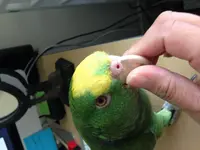Giving them the antibiotic in their beak with a syringe twice a day is a bit stressful to them but causes no physical harm which an injection might.
I respectfully disagree with you on this, Pajarita. If the injection is done properly, there is no risk, and it's SO easy to do, plus you always know your bird got the exact amount he/she needed, with no risk of aspiration. It's also much quicker than trying to force it down a struggling bird's beak.
I beg your pardon but there is risk and this is not my opinion. Please see below, this is listed under Complications/Limitations/Risk for Intramuscular injections in birds in Veterinary Techniques:
Volumes must be adjusted relative to muscle mass.
N.B. particularly important in small individuals (0.05ml in a canary is equivalent, volume-to-weight, to 40ml in a 25k.g. dog (
B13.17.w16).
Not feasible in all birds.
Significant tissue damage may result from intramuscular injections due to volume, formulation and dosage frequency. Both haematoma formation and necrosis may result.
Injection may be painful.
Some drug concentrations may require multiple sites per dose.
Drugs injected into the thigh (femoral muscles) may clear through renal portal system before absorption in some species.
Small birds may not have sufficient muscle mass to accommodate any injections.
(Pectoral muscle injections) in downies/fledglings in which the sternum is still cartilaginous this may be penetrated, with the injection being given into the liver.
(Femoral muscle injections) risk of damage to nerve along posterior aspect of femur.
And this is under Level of Expertise:
Procedure should only be undertaken by an individual with appropriate clinical training and practical experience; this would usually be someone with veterinary training.
As to dosage quantity, you can control that perfectly with a syringe as well. And although there is a danger of aspiration when giving liquids in a bird's beak, it disappears if you do it correctly and this is a technique that every bird keeper needs to master anyway because you never know when you might have to hand-feed the bird: towel bird wrapping towel around body and leaving head out, hold bird in non-dominant hand and arm with hand holding the back of the head placing index and thumb under ears, insert syringe tip on left side of beak with tip resting inside the beak and not in the throat.
I am more than VERY careful about my birds, I am borderline paranoid. I admit it. And the more I learn about them (and I do research all the time and study text books constantly) the more paranoid I become so I only allow injections in my birds when there is no other practical way of achieving the desired result and, in over 20 years of keeping birds, I think I can count with the fingers of one hand the times that this was necessary. And, as an interesting note, in some states, non-professional people injecting birds could be considered animal abuse (there was a case of a young man who rescued birds in NYC and they charged him with animal abuse because of this).



